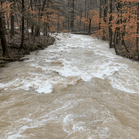-
Posts
5,107 -
Joined
-
Last visited
Content Type
Profiles
Blogs
Forums
American Weather
Media Demo
Store
Gallery
Everything posted by Holston_River_Rambler
-

January 15th-17th 2024 Arctic Blast/Snow Event
Holston_River_Rambler replied to John1122's topic in Tennessee Valley
I think that might have been a situation where it was modeling the thermals impacted by a relatively warm Lake Michigan, if I remember correctly, so that some of the Chicago suburbs got skunked closer to the Lake. But it still could be on to something else here -

January 15th-17th 2024 Arctic Blast/Snow Event
Holston_River_Rambler replied to John1122's topic in Tennessee Valley
WPC is still north: -

January 15th-17th 2024 Arctic Blast/Snow Event
Holston_River_Rambler replied to John1122's topic in Tennessee Valley
I think it sagged the precip axis a little south and cut down on qpf: 0z qpf on the left, 6z on the right: I'm not too concerned with that just yet. NAM is still waaayyy amped and RGEM is a nice compromise between the two. IMO this is going to be like some of what I call the Freaking Flooding February set ups we had in some of the past Springs. Not so much that we will get like 4-7" of qpf, but there will be a "snow hose" set up somewhere in the TN Valley and that qpf maximum will fluctuate based on things like terrain, the exact location/ strength of the jet that is facilitating this lift, and small vorticity maximums swinging through in the mid levels. as long as nothing makes a huge shift today, it's probably just a wait and see where it sets up and follow short term models. -

January 15th-17th 2024 Arctic Blast/Snow Event
Holston_River_Rambler replied to John1122's topic in Tennessee Valley
6z Euro: -

January 15th-17th 2024 Arctic Blast/Snow Event
Holston_River_Rambler replied to John1122's topic in Tennessee Valley
Man I thought I would wake up to more consensus this AM, but I think some of the wonkier solutions have doubled down. 6z GFS almost tried for the second wave again. Thanks to all y'all night owls for the good disco to catch up on. -

January 15th-17th 2024 Arctic Blast/Snow Event
Holston_River_Rambler replied to John1122's topic in Tennessee Valley
I just checked the Euro machine learning models and no dice there. To be clear they look very similar to the euro, but no crazy DGEX output -

January 15th-17th 2024 Arctic Blast/Snow Event
Holston_River_Rambler replied to John1122's topic in Tennessee Valley
You know what’s coming up in around an hour? -

January 15th-17th 2024 Arctic Blast/Snow Event
Holston_River_Rambler replied to John1122's topic in Tennessee Valley
I didn’t mean to spook anyone. I was just looking at the precip type fields and comparing to last run. I didn’t actually look at the qpf output. Sorry lol. -

January 15th-17th 2024 Arctic Blast/Snow Event
Holston_River_Rambler replied to John1122's topic in Tennessee Valley
qpf may have ticked down a smidge -

January 15th-17th 2024 Arctic Blast/Snow Event
Holston_River_Rambler replied to John1122's topic in Tennessee Valley
18z Euro looks like it will hold. Should have pics and gifs soon -

Winter 23-24' Wx Observations Thread
Holston_River_Rambler replied to Carvers Gap's topic in Tennessee Valley
Got this picture looking SE from North Greene County on I 81 exit 30. Pretty downsloping -

January 15th-17th 2024 Arctic Blast/Snow Event
Holston_River_Rambler replied to John1122's topic in Tennessee Valley
I can’t post the pic or gif but it looks like the 12z Euro is continuing the earlier trend of relaxing the suppression in front of the first overrunning wave. -

January 15th-17th 2024 Arctic Blast/Snow Event
Holston_River_Rambler replied to John1122's topic in Tennessee Valley
15z NBM ticked up a bit. -

January 15th-17th 2024 Arctic Blast/Snow Event
Holston_River_Rambler replied to John1122's topic in Tennessee Valley
IMO that was the best CMC so far. Just looking at surface stuff on tropical tidbits. up in Kingsport trying to break the EB so probably no maps from me until 18z Euro -

January 15th-17th 2024 Arctic Blast/Snow Event
Holston_River_Rambler replied to John1122's topic in Tennessee Valley
Euro seems to be ever so slightly easing off on the suppression over the past 3 runs: -

January 15th-17th 2024 Arctic Blast/Snow Event
Holston_River_Rambler replied to John1122's topic in Tennessee Valley
6z Euro: -

January 15th-17th 2024 Arctic Blast/Snow Event
Holston_River_Rambler replied to John1122's topic in Tennessee Valley
This may not be a huge deal, but height fields are a little less suppressed on the 6z Euro over the TN Valley and at hr 84: 6z on left, 0z on right: -

January 15th-17th 2024 Arctic Blast/Snow Event
Holston_River_Rambler replied to John1122's topic in Tennessee Valley
Just have to keep it together: EDIT (running joke about thunder in the mountains = snow; below is the GOES derived lightning product) -

January 15th-17th 2024 Arctic Blast/Snow Event
Holston_River_Rambler replied to John1122's topic in Tennessee Valley
IMO they seemed more optimistic for early next week than usual. Not sure if that is a good or a bad thing for my very weird snow superstitions at his range: Clouds increase on Sunday night into Monday, and light precipitation is forecast to overspread the region during the day on Monday. This will be in response to divergence associated with a strengthening 300mb 140 kt upper jet across the Central Appalachians through the Mid-Atlantic. Low-level convergent 850mb flow will increase and overrun the cold air at the surface. GFS forecast soundings for Monday show a saturated profile through the DGZ with temperatures below freezing through the entire atmosphere. Surface temperatures would likely be in the mid 20s while precipitation is falling which would result in higher SLRs. Deterministic models and ensembles are in good agreement with the setup for Monday. The big question is the exact amounts of QPF. The ECMWF is showing closer to 0.1 inch, the GFS is near 0.3 inch, and the GDPS is around 0.3 inch. With colder temperatures resulting in higher SLR of 12:1 to 16:1 according to the NBM on Monday afternoon through Tuesday morning, any small changes in liquid QPF will create large changes to expected snow totals. At this time, we will continue with around 0.2 inch QPF for this system which is producing a mean of 2 to 3 inches of snow. The NBM probabilities for 1 inch of snow in CHA is around 40 percent, at both TYS and TRI the probability is around 70 percent. As we head into Tuesday, bigger questions arise. The GFS and GDPS are more progressive and negatively tilted with the approaching shortwave and upper trough while the ECMWF is less progressive with this shortwave and results in a weaker surface low. While the deterministic ECMWF shows the weaker solution, many of its ensembles continue to show a stronger system with higher QPF and potential snow on Tuesday. For this reason, there is still a lot of uncertainty on Tuesday about any potential wrap around moisture with this southern low pressure system. With the stronger solution, we likely get another 0.1 to 0.3 QPF, and with the weaker solution, we get near nothing. The GFS ensembles are consistent with the stronger solution which would keep precip, and snow, around through Tuesday night, and perhaps Wednesday morning. These details won`t be resolved for several days. -

January 15th-17th 2024 Arctic Blast/Snow Event
Holston_River_Rambler replied to John1122's topic in Tennessee Valley
You and I are on a similar wave length. I was just reading the AFD too, lol. -

January 15th-17th 2024 Arctic Blast/Snow Event
Holston_River_Rambler replied to John1122's topic in Tennessee Valley
An ancient weenie rule, so prepare your bodies. The NAVGEM used to be considered to have the most progressive bias, so if it was more amped than some of the more reliable global OPs, it was a good bet that they would adjust to a more amped solution: -

January 15th-17th 2024 Arctic Blast/Snow Event
Holston_River_Rambler replied to John1122's topic in Tennessee Valley
Even the ever stingy NBM is looking acceptable this morning: -

January 15th-17th 2024 Arctic Blast/Snow Event
Holston_River_Rambler replied to John1122's topic in Tennessee Valley
It's a unique set up IMO -

January 15th-17th 2024 Arctic Blast/Snow Event
Holston_River_Rambler replied to John1122's topic in Tennessee Valley
18z : 12z: -

January 15th-17th 2024 Arctic Blast/Snow Event
Holston_River_Rambler replied to John1122's topic in Tennessee Valley
The 18z control was definitely a bad run for Nashville, but better for east TN folks. I would say it was on its own at 12z but if we count the Euro ensemble control as a low resolution version of the operational, that run was much better for eastern areas than 12z.






